Te Deum Window
The Te Deum Window

at Christ Church Mount Pellon
The West Window
The subject of the design is the Te Deum. The scheme has been to illustrate in the tracery above, the truths of the Christian Faith and of the Incarnation celebrated in the Hymn, and to introduce below figures typical of the Apostles, Prophets, Martyrs, and the Church; the various emblems of the characters chosen are shown on shields held by Angels, which appear among the vine leaves in the borders that run round each light. The vine border has been suggested by the words of our Lord (St. John xv, 5) "I am the Vine, ye are the branches; he that abideth in Me, and I in him, the same bringeth forth much fruit."

Tracery Lights

No. 1: The fig
ure of our Lord in Majesty, wearing royal and sacerdotal vestments, as King and Priest, at His feet are seen the colours of the rainbow. On the scroll are the words "Thou are the King of Glory, O Christ!"

No. 2: The Blessed Virgin and Child with attendant Angels worshipping. The words on the scroll are "When Thou tookest upon Thee to deliver man."
No. 3: The Crucifixion. Our Lord on the Cross with St. John and the Blessed Virgin. At the top above the arms of the Cross are the darkened sun and moon. The inscription on the scroll is "When Thou hadst overcome the sharpness of death."


 No. 4: The Cherubim and Seraphim. In one light are the words "To Thee Cherubim and Seraphim continually do cry," and in the other "Holy, Holy, Holy, Lord God of Sabboath."
No. 4: The Cherubim and Seraphim. In one light are the words "To Thee Cherubim and Seraphim continually do cry," and in the other "Holy, Holy, Holy, Lord God of Sabboath."
No. 5: The procession of the Holy Spirit. The seven rays proceeding  from the Holy Dove are emblematic of the seven-fold gift of the Spirit. At the top of the light is the Alpha and Omega in monogram, the symbol of the Eternal Godhead.
from the Holy Dove are emblematic of the seven-fold gift of the Spirit. At the top of the light is the Alpha and Omega in monogram, the symbol of the Eternal Godhead.
No. 7: The Heavenly Bodies, Sun Moon, and Stars, illustrating the words "The heavens and the powers therein."
The Lower Lights.
Row A
"The glorious company of the Apostles: Praise Thee."
The Apostles are seated on their thrones, holding their golden crowns. Reading from left to right, they appear in the following order, and their respective symbols will be found on the little shields near them in the borders.

St. Thomas with the builder's rule,
St. Simon with the saw,
St. Bartholomew with the knife,

St. Matthias with the spear,
St. John with the chalice,
St. James (Major) with the staff,

St. Philip with the cross or crozier,
St. Peter with the keys,
St. Andrew with the transverse cross,

St. James (Minor) with the club,
St. Matthew with the purse,
St. Jude (Thadeus) with the lance.
Row B
"The goodly fellowship of the Prophets: Praise Thee.
Reading from left to right the figures represented are:

Isaiah who holds the scroll on which the prophecies are written. His emblem is the saw.
Moses holds the Brazen Serpent, and has as his emblem the Tables of the Law.

St. John the Baptist with his emblem, The Lamb.
Elijah the anti-type of St. John the Baptist. He is unfastening his cloak which he handed on to Elisha when he was translated. His emblem is the Raven.

Daniel, wearing the costume of the Babylonians. (This dress has been copied from monuments in the British Museum). His emblem is the Lion.
Job, with his symbol of the sheaf of wheat in allusion to his prophecies about the Resurrection.

Anna the Prophetess, represented as a very old woman, her symbol being the pomegranate, the emblem of prophecy.
Samuel, wearing the Priestly vestments and with the censer as his emblem.
Row C
"The noble army of Martyrs: Praise Thee."
Reading from left to right the figures are:
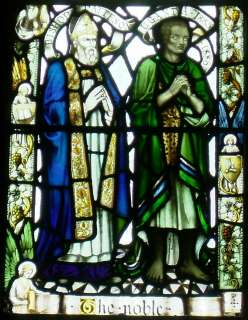
Bishop Patteson wearing cope, mitre, rochet, and surplice. This is a portrait of the Bishop. His emblem is the open Gospel.
The next figure is one of the Uganda Martyrs, of 1886. He is wearing a cloak over a leopard's skin as described in the account of the martyrdom. The emblem is the lighted faggot, the instrument of their martyrdom.
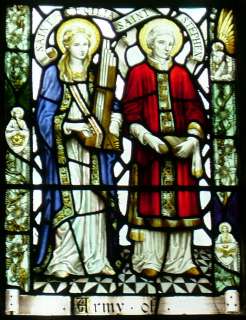
St. Cecilia, who lived in Rome during the third century. She has been regarded as the patroness of music and the inventor of the organ. She is represented as playing on the organ, wearing a wreath of roses. Her symbol is the rose, in allusion to the ancient legend of the weaving of her crown of roses by the angels which none but the faithful could see.
St. Stephen, the proto-martyr, holds a stone, the instrument of his martyrdom. He is, as a deacon, wearing the dalmatic and alb. His emblem is the Martyr's palm and crown.
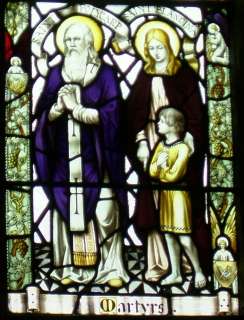
St. Polycarp, a pupil of St. John and martyr of the Eastern Church in 135 A.D., wearing the Eastern vestments. His emblem is the dove rising out of the flames.
St. Blandina, the slave-girl of Lyons in the south of France, who in the year 177 A.D. endured untold sufferings for Christ for many days, and encouraged her little brother to be faithful unto death. Her emblem is the net and scourge.

St. Oswald, of Northumbria, who after living and fightin
g for the Christian faith all his life was killed in battle against the heathen at Oswestry in 642. He is wearing the Anglo-Saxon costume of his period, and holding a sword. His emblem is the Hand, which after his death was retained as a relic by the monks of Lindisfarne.
St. Alban, the first British Martyr who suffered at the end of the third century at Verulanium, now St. Albans. He is dressed as a Roman soldier, and has for his emblem a fountain and a sword.
Row D
"The Holy Church throughout all the World, doth acknowledge Thee."
Reading from left the figures are:

St. Gregory the Great, 'the Apostle of England,' who sent St. Augustine to Kent in 597, clad in Pontifical vestments, his emblem being the Dove.
St. Athanasius, Bishop of Alexandria, the great champion of the Christian faith in the fourth century, wearing Greek Episcopal vestments. In the border is his symbol of the Trinity, the Triangle.

St. Augustine, of Canterbury, our first Archbishop, 597 A.D., in his Episcopal robes, his emblem is the arms of his see.
St. Aidan, a type of the early Celtic Church, and the Apostle of the north of England wearing the simplest form of vestments. His emblem is the flaming torch.
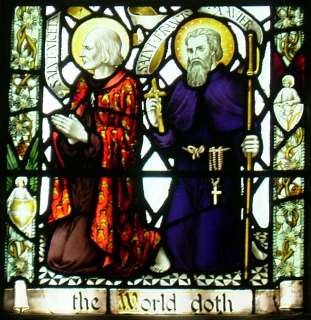
St. Niceta, of Remesiana, a Missionary Bishop in Servia, and hymn writer in the 5th century, the supposed writer of the Te Deum, having the cross as his emblem.
St. Francis Xavier, the 'Apostle of the East' who worked in India and Japan in the seventeenth century. He wears a simple kind of pilgrim's dress, and the head is copied from an ancient portrait. His emblem is the lily.
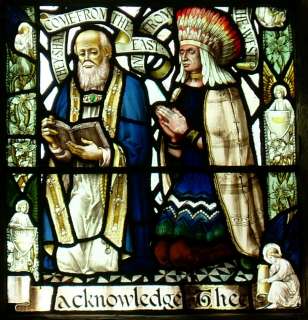
Father Goreh the Indian Missioner and apologist of our Church in the 19th century.
A Red Indian, typical of the Conversion of aboriginal American Continent. These two characters being typical of the East and West, the emblems chosen are the rising and setting sun.
IN making this design it has been the object of the artist to provide a simple straight-forward design, which will adequately illustrate the thoughts suggested by the Te Deum. He has also given a really rich effect of colour without in any way detracting from the light.
The Te Deum
WE praise thee, O God : we acknowledge thee to be the Lord.
All the earth doth worship thee : the Father everlasting.
To thee all angels cry aloud : the heavens and all the powers therein.
To thee Cherubin and Seraphin : continually do cry,
Holy, Holy, Holy : Lord God of Sabaoth;
Heaven and earth are full of the majesty : of thy glory.
The glorious company of the apostles : praise thee.
The goodly fellowship of the prophets : praise thee.
The noble army of martyrs : praise thee.
The holy Church throughout all the world : doth acknowledge thee;
the Father : of an infinite majesty;
thine honourable, true : and only Son;
also the Holy Ghost : the Comforter.
Thou art the King of glory : O Christ.
Thou art the everlasting Son : of the Father.
When thou tookest upon thee to deliver man : thou didst not abhor the Virgin's womb.
When thou hadst overcome the sharpness of death :
thou didst open the kingdom of heaven to all believers.
Thou sittest at the right hand of God : in the glory of the Father.
We believe that thou shalt come : to be our judge.
We therefore pray thee, help thy servants : whom thou hast redeemed with thy precious blood.
Make them to be numbered with thy Saints : in glory everlasting.
O Lord, save thy people : and bless thine heritage.
Govern them : and lift them up for ever.
Day by day : we magnify thee;
and we worship thy Name : ever world without end.
Vouchsafe, O Lord : to keep us this day without sin.
O Lord, have mercy upon us : have mercy upon us.
O Lord, let thy mercy lighten upon us : as our trust is in thee.
O Lord, in thee have I trusted : let me never be confounded.



